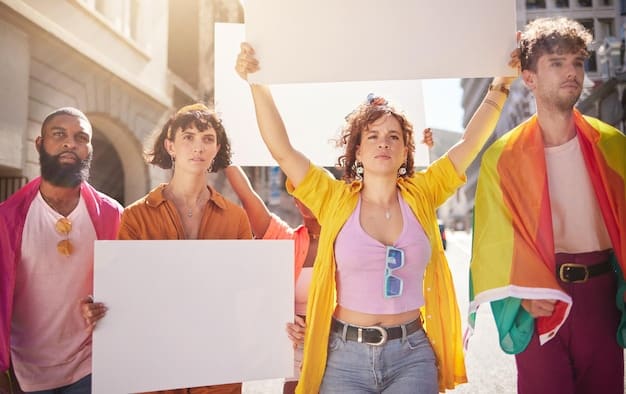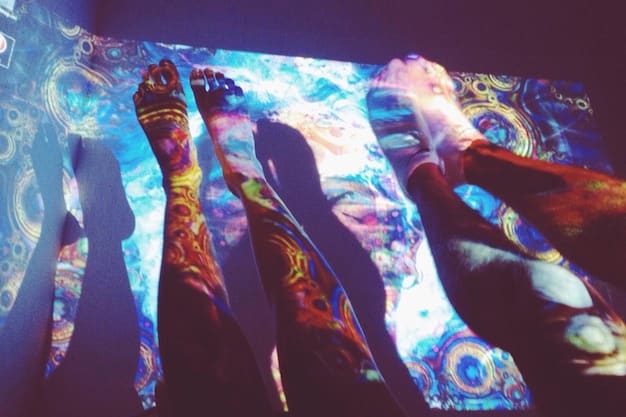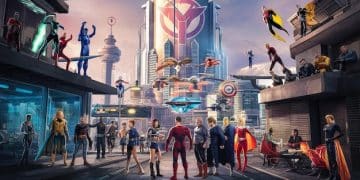Pop Culture & Social Activism: A Growing Movement Reshaping Society

The intersection of pop culture and social activism has created a powerful, evolving movement, leveraging widespread media influence to amplify important messages and mobilize audiences for social change.
From protest anthems to blockbuster films, the synergy between pop culture and social activism: a growing movement is undeniable. This dynamic relationship leverages popular media to ignite conversations, challenge norms, and inspire collective action.
The origins of activist art and media
The threads connecting art, entertainment, and social change are woven deep into human history. From ancient theatrical critiques of governance to folk songs of rebellion, cultural expression has always provided a platform for dissent and advocacy. Understanding these historical roots helps contextualize the potent impact observed today.
In various eras, artists, musicians, and performers have often been at the forefront of social movements. Their work provides a voice for the voiceless, distilling complex issues into accessible, emotionally resonant narratives. This ability to encapsulate vast societal challenges within a memorable format is critical for engagement.
Early forms of cultural protest
Before mass media, storytelling and public performance served as vital tools for social commentary and mobilization. These forms were typically localized but highly effective within their communities.
- Theatrical performances: Ancient Greek comedies often satirized political figures and societal flaws, sparking public debate.
- Folk music: Ballads and protest songs from the American Civil Rights Movement to anti-war movements captivated large audiences.
- Literature: Novels like “Uncle Tom’s Cabin” significantly influenced public opinion on slavery in the 19th century.
The consistent pattern demonstrates that popular cultural forms, no matter their medium, possess an inherent power to both reflect and shape public consciousness. They offer a mirror to society while simultaneously suggesting paths forward for change.
Over time, as technology advanced, so did the reach of these cultural expressions. The advent of radio, then television, and now digital platforms has exponentially expanded the audience, making the link between pop culture and social change even more robust.
This historical trajectory underscores that the current collaboration between pop culture and activism is not a fleeting trend. Instead, it is an evolution of a long-standing tradition, adapted for a hyper-connected, globalized world. The impact is magnified by the immediacy and omnipresence of media.
How pop culture amplifies social messages
Pop culture operates within a vast, interconnected network, reaching audiences that traditional activism might struggle to engage. Its power lies in its ability to embed social messages within entertainment, making them digestible and relatable to a diverse demographic. This subtle dissemination of ideas can be profoundly effective.
When a popular song addresses mental health stigma or a prominent film tackles environmental justice, these issues gain visibility beyond activist circles. The emotional connection fostered by art allows for a deeper understanding and empathy from viewers and listeners. This pathway bypasses typical barriers to engagement, creating a more receptive audience.
The role of celebrity advocacy
Celebrities, as figures central to pop culture, wield considerable influence. Their endorsement of social causes can bring immediate, widespread attention and legitimacy. However, the impact varies based on authenticity and sustained commitment.
- Increased visibility: A celebrity tweet or statement can reach millions instantly, highlighting issues previously ignored.
- Fundraising power: High-profile figures can mobilize significant monetary support for charitable organizations.
- Role modeling: Celebrities who demonstrate ethical behavior and social responsibility can inspire their fans to follow suit.
While celebrity involvement can be a powerful catalyst, it also brings scrutiny. Authenticity is paramount; audiences are increasingly discerning of performative activism. Genuine engagement, rather than mere endorsement, fosters lasting impact and trust.
Beyond individual celebrities, entire franchises and media platforms are consciously integrating social messages into their content. This integration is moving beyond tokenism, aiming for narrative depth that genuinely explores complex societal issues. This deliberate approach often leads to more profound, long-term conversations.
The amplification happens not just through direct messaging, but also through representation. When diverse characters, storylines, and perspectives become mainstream, they normalize previously marginalized experiences, fostering greater understanding and acceptance within society. This subtle shift is perhaps one of the most powerful contributions of pop culture to social progress.

Key examples of pop culture-driven movements
The past decade has seen an acceleration in the explicit embrace of social activism by popular culture. These movements often gain significant momentum due to the emotional resonance and widespread reach of the cultural artifacts themselves. From music to film, television, and digital content, each medium offers a unique pathway for advocacy.
One prominent example is the impact of musical artists. Beyoncé’s “Formation” and Kendrick Lamar’s “Alright” became intertwined with the Black Lives Matter movement, providing anthems that energized protesters and raised awareness globally. These songs transcended mere entertainment, becoming symbols of resistance and resilience.
Film and television driving narratives
Filmmakers and showrunners are increasingly using their platforms to explore and challenge social injustices. These productions often spark national conversations and expose audiences to perspectives they might not otherwise encounter.
- “Black Panther”: Beyond its superhero narrative, the film celebrated African heritage and challenged stereotypes, becoming a cultural touchstone for representation.
- “When They See Us”: Ava DuVernay’s miniseries shed light on systemic racism within the justice system, prompting critical re-evaluations of historical cases.
- “Pose”: This series brought the realities of the LGBTQ+ ball culture and the AIDS epidemic into mainstream conversation, fostering empathy and understanding.
These examples illustrate how entertainment can serve as a trojan horse for social education, making complex issues accessible and emotionally impactful. The shared experience of consuming these media creates a collective understanding and often motivates further research or advocacy.
Digital platforms, with their lower barriers to entry, have also become fertile ground for activist content. YouTube creators, TikTok influencers, and podcasters often address social issues directly, fostering niche communities around specific causes. This decentralized approach allows for more diverse voices and immediate responses to current events.
The combination of artistic expression with a clear social agenda is what defines these pop culture-driven movements. They are not merely reflections of society but active participants in its evolution, using their massive platforms to advocate for a more equitable and conscious world.
The rise of digital activism and fandon engagement
The digital age has fundamentally reshaped how social activism integrates with pop culture, largely through the direct engagement of fandoms. Online platforms provide unprecedented opportunities for fans to organize, advocate, and amplify messages related to their favorite artists or media. This symbiotic relationship has transformed passive consumption into active participation.
Social media platforms are the primary battleground where this digital activism flourishes. Hashtag campaigns, viral challenges, and meme culture often emerge from fan communities, pushing specific social issues into the mainstream. The speed and reach of these digital movements can be staggering, leading to real-world impacts.
Fan communities as social catalysts
Fandoms, traditionally spaces for shared appreciation, have evolved into powerful social and political forces. United by a common interest, these communities can quickly mobilize resources and attention for causes aligned with their values or the values expressed within their chosen media.
- Crowdfunding: Fans organize to raise money for charitable causes endorsed by their idols or relevant to a media narrative.
- Online petitions: Large fan bases can generate massive signatures for petitions, influencing corporate or governmental decisions.
- Awareness campaigns: Through shared content and discussions, fandoms disseminate information and combat misinformation on social issues.
This decentralized, grassroots approach to activism is particularly effective because it leverages pre-existing networks of trust and shared identity. The emotional investment fans have in their idols often translates into a deeper commitment to the causes these idols support, either explicitly or implicitly through their work.
The interactive nature of digital media further blurs the lines between creator and audience. Fans can now directly communicate with artists, influencing narratives and demanding accountability. This two-way street fosters a sense of shared responsibility for social change, moving beyond a top-down model.
However, digital activism also presents challenges, including the risk of performative online actions that lack tangible real-world impact, and the potential for echo chambers. Nevertheless, the capacity for rapid mobilization and global reach makes fandon engagement a critical component of contemporary pop culture activism.
Challenges and criticisms of pop culture activism
Despite its growing influence, the intersection of pop culture and social activism is not without its complexities and critics. The entertainment industry’s embrace of social causes often raises questions about authenticity, effectiveness, and potential pitfalls. Navigating these challenges is crucial for fostering genuine and lasting change.
One major criticism revolves around “slacktivism” or “performative activism.” This refers to actions, often online, that require minimal effort but provide the individual or brand with an appearance of social consciousness without contributing to meaningful change. Posting a black square on Instagram, for instance, without deeper engagement, can be seen as an example.
Authenticity versus commodification
A significant tension exists between genuine advocacy and the commercial interests of the entertainment industry. When activism becomes trendy, there’s a risk of commodification, where social causes are exploited for profit or public relations rather than pursued for their inherent value.
- Tokenism: Including diverse characters without genuine narrative depth or systemic change within the industry.
- Brand co-option: Corporations adopting social justice language or imagery for marketing, without significant commitment to the underlying issues.
- Surface-level engagement: Addressing problems superficially to avoid alienating audiences or disrupting existing power structures.
Critics also point out that pop culture’s reach doesn’t automatically translate to deep understanding or action. While awareness can be raised, the nuanced complexities of social issues might be oversimplified for mass consumption, potentially leading to misinterpretations or a lack of sustained engagement.
There’s also the risk of alienating certain segments of the audience if political messages become too overt or prescriptive, potentially hindering the broader appeal that pop culture typically aims for. Balancing entertainment value with social messaging is a delicate act that can backfire if not handled thoughtfully.
Ultimately, the effectiveness of pop culture activism hinges on its ability to move beyond symbolism to substance. It must convert increased awareness into tangible support for movements, organizations, and policy changes while maintaining a critical eye on the motives and impacts of its own contributions.
The future trajectory of cultural impact
The evolving landscape of media consumption and social consciousness suggests that the link between pop culture and social activism will only strengthen. As younger, more socially aware generations become dominant consumers, the demand for meaningful and impactful content will likely increase. This shift will further push creators and industries to deepen their engagement with societal issues.
New technologies, such as virtual reality (VR) and augmented reality (AR), offer unprecedented opportunities for immersive storytelling that can transport audiences directly into the lived experiences of others, fostering even greater empathy and understanding. Imagine a VR experience that simulates systemic injustice, making its impact palpable.
Interactive media and personalized engagement
The future will likely see even more interactive forms of media that allow audiences to participate directly in narratives involving social issues. This could range from choose-your-own-adventure style narratives on social media to games directly tied to charitable efforts or educational campaigns.
- Personalized content: AI-driven platforms could tailor social messages to resonate specifically with individual users, increasing impact.
- Gamification of activism: Incorporating game mechanics into social campaigns to make engagement more enjoyable and rewarding.
- Decentralized creation: Further empowerment of independent creators to produce impactful content outside traditional media gatekeepers.
The rise of creator economies, where artists can directly monetize their work and connect with audiences, provides a more autonomous space for politically charged art. This reduces reliance on large corporations that might shy away from controversial topics, fostering a more diverse range of voices and perspectives.
However, increased connectivity also brings challenges, such as the spread of misinformation and the fragmentation of audiences into echo chambers. Therefore, the future trajectory will also involve a greater emphasis on media literacy and critical engagement with content, both by creators and consumers.
In conclusion, the symbiotic relationship between pop culture and social activism is poised for continued growth and innovation. Its capacity to mobilize, educate, and inspire through captivating storytelling remains immense, making it a critical force in shaping future societal change and conversation.
| Key Aspect | Brief Description |
|---|---|
| 🎤 Cultural Amplification | Pop culture uses its broad reach to disseminate social messages, making them accessible and relatable for mass audiences. |
| 🤝 Fandom Engagement | Online fan communities actively mobilize for social causes, leveraging their collective power for awareness and action. |
| 🎬 Narrative Power | Films, TV shows, and music often embed social narratives, sparking critical conversations and fostering empathy. |
| 💡 Future Innovation | New technologies like VR/AR and interactive media promise even deeper, more immersive activist experiences. |
Frequently Asked Questions about Pop Culture and Social Activism
▼
Pop culture influences social change by embedding important messages within widely consumed media like music, films, and TV shows. This makes complex social issues accessible and relatable to a diverse audience, fostering empathy and encouraging dialogue that can lead to shifted perspectives and collective action.
▼
Key examples include Beyoncé’s “Formation” and Kendrick Lamar’s “Alright” becoming anthems for the Black Lives Matter movement, or the film “Black Panther” celebrating Black identity and challenging stereotypes. These works galvanized audiences and amplified messages, contributing significantly to social discourse and mobilization.
▼
Slacktivism refers to low-effort online actions, such as sharing a hashtag or changing a profile picture, that give an appearance of social support without requiring significant commitment or yielding substantial real-world impact. Critics argue it can dilute genuine activism by prioritizing superficial engagement over meaningful action.
▼
Yes, celebrity involvement can be problematic if it lacks authenticity, leads to commodification of social causes, or simplifies complex issues. While celebrities bring immense visibility and fundraising potential, their actions are often scrutinized for performative activism, which can undermine the credibility of the movement itself.
▼
Fan communities leverage their collective power and online presence to amplify social messages. They organize viral campaigns, petitions, and crowdfunding efforts, leveraging their shared passion to advocate for causes aligned with their values or those promoted by their favorite artists, demonstrating a powerful form of grassroots mobilization.
Conclusion
The symbiotic relationship between pop culture and social activism is not merely a fleeting trend but a potent, evolving force. It has consistently demonstrated its capacity to transcend traditional boundaries, embedding critical social messages within compelling narratives that resonate globally. As technology advances and societal awareness grows, this dynamic interaction promises an even more integrated future, where entertainment continues to be a driving engine for progress, education, and collective action, ultimately shaping a more conscious and engaged global citizenry. The journey from reflection to active change through popular media is a testament to culture’s enduring power.





